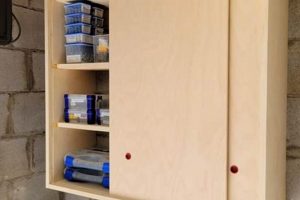A self-constructed wooden access point for vehicular storage represents a significant undertaking in home improvement. This type of project involves the design, fabrication, and installation of a large, often sectional, barrier intended to secure and enclose a garage. Success hinges on careful planning, precise execution, and a thorough understanding of both carpentry principles and the operational mechanics involved in garage door systems.
The appeal of this approach often stems from the desire for cost savings and the satisfaction derived from hands-on creation. Moreover, it allows for customization that may not be readily available through commercial vendors. A handcrafted barrier can be specifically tailored to complement the architectural style of a home, utilizing unique wood species, finishes, and decorative elements. Historically, these types of builds were more prevalent, before mass manufacturing offered more accessible alternatives.
The following sections will explore the key considerations for embarking on such a project. This includes material selection, design considerations, structural integrity, the integration of hardware, safety protocols, and the challenges associated with achieving a durable, functional, and aesthetically pleasing final product.
Guidance for Wooden Garage Door Construction
The creation of a custom wooden garage door demands meticulous attention to detail and adherence to established construction practices. The following tips are designed to guide the process, enhancing both the structural integrity and operational reliability of the finished product.
Tip 1: Prioritize Accurate Measurements. Before any cutting or assembly, obtain precise measurements of the garage door opening. Ensure that all dimensions are square and level. Discrepancies at this stage will propagate throughout the project, potentially leading to operational issues and aesthetic compromises.
Tip 2: Select Appropriate Wood Species. The choice of wood is critical for both durability and visual appeal. Consider rot-resistant species such as cedar, redwood, or treated lumber. Ensure that the wood is properly dried and acclimated to the local climate to minimize warping or cracking after installation.
Tip 3: Employ Robust Joint Construction. Utilize strong, interlocking joints such as mortise and tenon, dovetail, or rabbet joints to ensure structural integrity. Reinforce joints with high-quality exterior-grade adhesive and fasteners, paying particular attention to load-bearing areas.
Tip 4: Integrate Proper Bracing. Implement diagonal bracing to prevent sagging and maintain squareness. Strategic placement of metal or wooden bracing will significantly enhance the door’s resistance to warping and twisting under its own weight.
Tip 5: Utilize High-Quality Hardware. Select garage door hardware specifically designed for heavy wooden doors. This includes hinges, rollers, tracks, and springs. Ensure that the hardware is properly rated for the weight of the door to ensure smooth and safe operation.
Tip 6: Apply a Durable Finish. Protect the wood from moisture and UV exposure with a high-quality exterior-grade paint, stain, or sealant. Multiple coats are recommended, with particular attention paid to end grain and exposed edges.
Tip 7: Ensure Proper Insulation (Optional). If energy efficiency is a concern, consider integrating insulation panels into the door’s construction. Secure insulation within the door frame to minimize heat transfer and improve thermal performance.
Tip 8: Prioritize Safety Considerations. Garage doors are heavy and potentially dangerous. Install safety cables on the springs to prevent injury in the event of spring failure. Regularly inspect all components for wear and tear, and address any issues promptly.
Adherence to these recommendations can significantly increase the likelihood of a successful and long-lasting wooden garage door build. The result is a custom access solution that enhances both the functionality and the aesthetic appeal of the property.
The subsequent sections will delve into the specific steps involved in the installation process, providing detailed guidance on mounting the door, connecting the hardware, and adjusting the spring tension for optimal performance.
1. Material Selection
Material selection is paramount in the construction of wooden garage doors, directly impacting the door’s lifespan, structural stability, and aesthetic quality. The chosen wood species must withstand environmental stressors, including moisture, temperature fluctuations, and potential insect infestation. Inadequate material selection invariably leads to premature deterioration, functional impairment, and increased maintenance requirements. For instance, utilizing untreated pine in a humid climate will likely result in rot and warping, necessitating costly repairs or complete replacement within a relatively short timeframe.
Furthermore, the weight of the selected material significantly influences the required hardware and operational mechanics of the door. A heavier wood species necessitates a more robust spring system and sturdier hinges to ensure smooth and safe operation. Failure to account for material weight can compromise the door’s balance, potentially leading to operational failures and posing safety hazards. Conversely, selecting a lightweight but structurally unsound material may result in a door that lacks durability and is susceptible to damage from impact or wind pressure.
Therefore, informed decision-making regarding material selection is not merely an aesthetic consideration but a fundamental aspect of ensuring the longevity, functionality, and safety of a wooden garage door. Proper material selection mitigates risks associated with environmental degradation, ensures compatibility with hardware components, and contributes to the overall structural integrity of the final product. Selecting appropriate wood from the outset prevents future complications.
2. Structural Design
The structural design is a critical determinant of a wooden garage door’s functionality and longevity. A poorly conceived design invites a cascade of potential issues, ranging from operational difficulties to premature structural failure. The weight of wood, particularly when compounded by the dimensions of a garage door, necessitates a design that effectively distributes load and resists deformation. Inadequate bracing, for instance, can lead to sagging, making the door difficult to open and close, and ultimately shortening its lifespan. A sectional door without properly reinforced panels may experience panel separation, compromising both security and weather resistance. Successful projects hinge on a well-engineered plan that anticipates and mitigates these inherent challenges.
Effective structural design also considers the integration of hardware components. The placement and attachment points for hinges, rollers, and springs directly influence the door’s operational smoothness and safety. Improperly positioned hinges can create undue stress on the doorframe, leading to warping or cracking. Insufficient support for the spring mechanism increases the risk of spring failure, potentially causing injury or property damage. A design that anticipates these interactions ensures that the hardware functions optimally and contributes to the overall structural integrity of the door. Examples include using heavier gauge steel for hinge mounting plates or incorporating load-bearing supports at critical stress points.
In conclusion, the structural design is not merely an aesthetic consideration but the foundational element upon which a durable and functional wooden garage door is built. It demands careful planning, precise execution, and a thorough understanding of structural principles. A well-engineered design anticipates potential weaknesses, integrates hardware effectively, and ensures the door’s long-term reliability and safety. Overlooking this critical aspect can lead to costly repairs, operational difficulties, and a significantly reduced lifespan for the finished product.
3. Hardware Integration
Hardware integration is a critical facet of constructing a wooden garage door. The successful operation, safety, and longevity of the finished product are intrinsically linked to the selection, installation, and proper functioning of its constituent mechanical components. These elements, often overlooked in favor of aesthetic considerations, are integral to ensuring the door performs as intended.
- Hinge Selection and Placement
Hinges bear the load of the door sections and facilitate their movement. Selection depends on the door’s weight and thickness. Incorrect placement can induce stress concentrations, leading to warping or joint failure. For example, insufficient hinge spacing on a heavy door can cause the panels to sag, hindering smooth operation and potentially damaging the door frame.
- Spring System Calibration
Torsion or extension springs provide the counterbalancing force necessary to lift the door. Accurate calibration is essential; an under-tensioned spring system renders the door difficult to open, while an over-tensioned system poses a safety hazard. The spring’s lifespan is also affected, as improper calibration accelerates wear and tear. Neglecting spring calibration could lead to a door that is either too heavy to lift or slams down with excessive force.
- Roller and Track Compatibility
Rollers guide the door along the tracks, dictating the smoothness and quietness of its movement. Using incompatible rollers and tracks results in friction, noise, and premature wear. For instance, nylon rollers on a steel track might be quieter initially, but their lifespan is shorter compared to steel rollers on a properly lubricated steel track. Misalignment of the track can cause rollers to bind, halting or impeding the door’s motion.
- Locking Mechanisms and Security
Locking mechanisms provide security against unauthorized entry. A robust and reliable locking system is particularly important for garage doors that provide access to the home. Weak or poorly installed locks can be easily bypassed, compromising the security of the property. Selection of appropriate deadbolts or slide locks must be integrated to the structural aspects to be effective.
The integration of appropriate hardware is not merely a supplementary task but a fundamental aspect of “diy wood garage door” construction. Correct hardware selection and installation are essential for ensuring a safe, functional, and durable final product, negating the need to call the expert to fix it.
4. Finishing Techniques
Finishing techniques are integral to the longevity and aesthetic appeal of a self-constructed wooden garage door. The application of appropriate protective coatings and treatments directly influences the wood’s resistance to environmental factors, such as moisture, ultraviolet radiation, and insect infestation. Without proper finishing, even the most carefully constructed door will be susceptible to degradation, leading to warping, cracking, rot, and ultimately, structural failure. A real-world example is the premature decay observed in untreated wooden garage doors exposed to coastal climates, where salt spray and high humidity accelerate wood rot. Therefore, selecting and implementing suitable finishing techniques is a critical component of the building process.
The choice of finishing technique depends on several factors, including the type of wood used, the desired aesthetic, and the prevailing climate. Penetrating oil finishes, for instance, offer excellent moisture resistance but may require more frequent reapplication compared to film-forming finishes like paints or varnishes. Paints provide superior UV protection, preventing the wood from fading and cracking, but can obscure the natural grain pattern. The proper application of any finish necessitates thorough surface preparation, including sanding, cleaning, and priming. Failure to prepare the surface adequately will result in poor adhesion and a compromised protective barrier. Consider the example of a door stained without prior sanding; the stain will not penetrate evenly, resulting in a blotchy and uneven appearance.
In conclusion, appropriate finishing techniques are not merely cosmetic enhancements but essential investments in the durability and performance of the door. They are a key line of defense against environmental stressors and play a significant role in maintaining the door’s structural integrity and aesthetic appeal over time. Furthermore, proper selection and application of finishing materials extend the lifespan of the “diy wood garage door”, minimizing the need for costly repairs or replacements. Ignoring this aspect can lead to long-term issues.
5. Operational Safety
The intersection of operational safety and wooden garage doors, particularly those constructed through do-it-yourself methods, is a critical area of concern. A heavy garage door, when improperly balanced or lacking adequate safety mechanisms, presents a substantial risk of injury or property damage. The mass of a wooden door, combined with the potential energy stored in the spring system, creates a hazardous situation if components fail or are incorrectly installed. For example, a snapped torsion spring on a poorly maintained door can cause the door to slam shut with significant force, posing a threat to anyone in its path. The inherent dangers underscore the necessity for rigorous adherence to safety protocols throughout the design, construction, and installation phases.
Several specific safety considerations warrant emphasis. The installation of safety cables, designed to restrain the spring in the event of failure, is paramount. Correct spring tensioning, verified through precise measurement and adjustment, ensures smooth operation and reduces the risk of sudden door movements. Photoelectric sensors, which prevent the door from closing if an obstruction is detected, provide an additional layer of protection. Regular inspection of all components, including hinges, rollers, cables, and springs, is essential for identifying and addressing potential weaknesses before they escalate into dangerous situations. Failure to implement these measures increases the likelihood of accidents, highlighting the practical significance of prioritizing safety.
In summary, operational safety is not a supplementary consideration, but an indispensable element of a wooden garage door project. Neglecting safety protocols can lead to severe consequences, including personal injury and property damage. A comprehensive approach to safety, encompassing design, installation, maintenance, and regular inspections, is crucial for mitigating risks and ensuring the safe and reliable operation of a self-constructed wooden garage door. Therefore, prioritizing the safety aspect is not just advisable; it is essential to a successful build.
Frequently Asked Questions
The following addresses common inquiries regarding the design, construction, and maintenance of garage doors fabricated from wood.
Question 1: What types of wood are most suitable for garage door construction?
Wood species exhibiting natural resistance to decay and insect infestation are recommended. Cedar, redwood, and treated lumber are common choices. The selection process also considers the wood’s density and stability to minimize warping and cracking.
Question 2: Is it possible to automate a wooden garage door, and what are the limitations?
Automating a wooden garage door is feasible, provided the opener is appropriately rated for the door’s weight and size. Heavier wooden doors may require more powerful openers and reinforced hardware to ensure reliable and safe operation. Regular maintenance of the opener and door mechanisms is crucial.
Question 3: How can a wooden garage door be effectively insulated?
Insulation panels can be integrated into the door’s construction. Rigid foam insulation is typically cut to fit within the door frame and secured with adhesive. Ensure proper sealing around the insulation to prevent moisture intrusion and maintain thermal efficiency.
Question 4: What are the primary maintenance requirements for a wooden garage door?
Regular maintenance includes inspecting and lubricating hinges, rollers, and springs. The wood finish should be inspected annually and reapplied as needed to protect against moisture and UV damage. Promptly address any signs of rot, warping, or insect infestation.
Question 5: How does the cost of constructing a wooden garage door compare to purchasing a pre-fabricated door?
The cost can vary significantly depending on the wood species, design complexity, and hardware selection. Self-construction may offer cost savings in some cases, but it requires significant labor and expertise. Pre-fabricated doors offer convenience and often come with warranties, but may lack the customization options of a self-built door.
Question 6: What safety precautions should be observed during the construction and installation of a wooden garage door?
Safety cables should be installed to prevent injury in the event of spring failure. Ensure proper spring tensioning and balance. Use appropriate lifting equipment and seek assistance when handling heavy components. Consult local building codes and obtain necessary permits before commencing the project.
Careful planning and execution, combined with adherence to safety guidelines, are essential for a successful wooden garage door. This endeavor requires significant time and commitment.
The subsequent section presents a detailed guide to installing a homemade wooden garage door.
Concluding Remarks
The preceding discussion has examined the multifaceted aspects of constructing a wooden garage door independently. From material selection and structural design to hardware integration, finishing techniques, and operational safety, each stage demands meticulous planning and precise execution. Understanding the intricacies of each element is paramount to achieving a functional, durable, and aesthetically pleasing final product. The information presented underscores the significant commitment of time, resources, and expertise required for this undertaking.
Ultimately, the decision to pursue a “diy wood garage door” project hinges on a realistic assessment of one’s capabilities and resources. While the potential for customization and cost savings may be appealing, a thorough understanding of the challenges and responsibilities involved is crucial. Prospective builders are urged to carefully consider the information presented and to prioritize safety and structural integrity throughout the entire process. Informed planning and diligent execution remain the cornerstones of success in this challenging endeavor.







